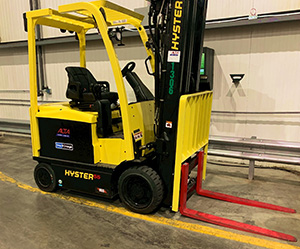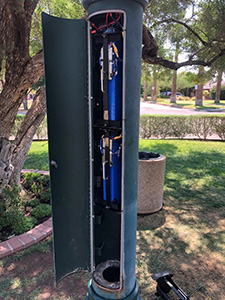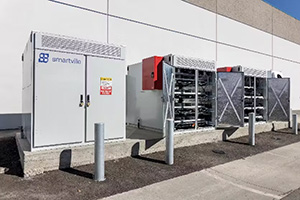“We support circular economy entrepreneurs who are helping to achieve community-wide waste diversion goals,” says Amanda Jordan, Circular Economy project manager for the City of Phoenix.
Executive Summary
Lithium batteries are enabling the energy transition in many industries and are experiencing explosive growth in demand across many industries and geographic locations. At the end of their expected useful life of 5–10 years, lithium batteries are thoroughly tested and repurposed for less power-intensive applications, such as energy storage, and continue to work for another 5–10 years.
The low cost of the used lithium cells used in solar energy generation systems drives down the price of renewable energy for end users. The repurposing of lithium batteries reduces waste and the energy required for recycling. These benefits make lithium battery technology the most sustainable power source on the market.
Challenges
There has been a significant rise in the production of lithium-ion batteries, primarily due to their fast-growing use in electric vehicles, electric industrial equipment such as forklifts, power storage for renewable energy generation, emergency power storage for IT and telecommunications, medical equipment, home appliances, and electronics.
As a result of a sky-rocketing increase in demand, the cost per kWh for lithium batteries has increased for the first time in 2022, leading to higher costs for the buyers of energy storage batteries in renewable power generating systems.
Even with the increasing rate of lithium battery recycling, there is a need to dramatically reduce the amount of waste from the anticipated influx of batteries reaching their end of useful life.
Solution: OneCharge Lithium Cells Are Reincarnated at Bluewater Battery Logistics
OneCharge started lithium forklift battery manufacturing in 2014, and most of its battery packs are still in the field, well beyond their 5-year warranty term. But some batteries are shipped back to the company before the end of their useful life for various reasons such as the end of a trial period, or physical damage.

Hyster 4 wheel sit-down Class 1 Forklift
The story of one particular OneCharge 80V 360Ah LFP forklift battery began in a Hyster E55XN Class I sit-down lift truck, operating in a packaging facility of a fruit-producing company in the state of Washington, USA. This was a demo project to evaluate the benefits of lithium batteries compared to lead-acid, and after the trial period, this customer of OneCharge ordered bigger-capacity 630Ah 80V lithium batteries and switched its fleet to single-battery multi-shift operations.
Our demo battery came back to Onecharge, with many years of life left in each cell, but with no chance to be used in a new forklift battery again.
Fortunately, in 2022 OneCharge partnered with Bluewater Battery Logistics to repurpose and recycle lithium forklift batteries. Bluewater tests and evaluates batteries, and sends dead cells for hydrometallurgical recycling. Other cells find new applications. “Bluewater Battery evaluates a few variables to find the optimum way to repurpose the batteries for a second life and minimize the environmental impact,” explains Steve Feinberg, CEO at Bluewater. “We look at the condition of the cells, geographical location for minimal shipping, and our partners’ expertise to repurpose batteries.” The batteries’ new lives in secondary applications depend on how they fare in tests of voltage, Ah capacity, and various state of health (SOH) parameters.
This is how the LFP prismatic lithium cells from the Washington demo battery got to battery purgatory at Bluewater, where they were analyzed and their next life was determined.
Results: Second Life for Lithium Forklift Battery
BlueWater partners with several companies building innovative solutions to repurpose lithium cells for various applications. One of them is HigherWire, which focuses on small- and medium-capacity users up to 50kWh, with a plan for 2023 to have a few thousand total kWh installed.
Since 2019, HigherWire has been acquiring used lithium batteries from forklifts, EVs, and golf carts. The company accepts smaller 18650 cells from e-bike and scooter batteries, and even smaller cells from consumer electronics.
Solar energy storage installation site at South Mountain Park, City of Phoenix
“It is really important to be able to accurately estimate batteries’ SOH,” says Trevor Warren, CEO of HigherWire. “We want to make the whole concept of repurposed lithium batteries more viable and drive the cost down.” Trevor suggests that every battery needs a digital “passport” with reliable data on usage and current state. There are significant savings in labor and energy costs for testing the cells, as well as additional trust from the end user.

Solar energy storage installation site at South Mountain Park, City of Phoenix
A good example of the use of the HigherWire solution is through the pilot project with the City of Phoenix .“Here at the city, we want to be supporters of circular economy entrepreneurs helping our region transition from the linear economy and keep waste out of the landfill,” says Amanda Jordan, Circular Economy project manager for the City of Phoenix.
Jordan is partnering with Higherwire on a pilot project to use remanufactured lithium batteries for solar panel energy storage to power lighting in South Mountain Park. The pilot kicked off on June 9, 2023, and will continue for one year. The major concern has always been the batteries’ resistance to Arizona heat. “The positive outcome of this project will pave the road to the mass usage of second-life lithium cells as energy storage for the renewables (in Arizona).”
This is where the story of OneCharge demo battery ends. The lithium cells used in a forklift at the fruit packaging facility ended up in the energy storage for a solar array and are expected to work reliably for another 10 years.
U.S. will surpass 1 million annual EV sales in 2023 and used EV batteries will provide used lithium cells for bigger-scale projects. “We work to directly repurpose EV battery packs across a few different OEMs,” says Antoni Tong, CEO at Smartville, which currently has multiple grid-interconnected projects under development. “[Repurposing used lithium batteries] supports domestic supply chain and manufacturing,” explains Tong.

UC San Diego 500 kWh solar energy storage
Conclusion
Energy transition, which plays a vital part in fighting climate change is enabled in many aspects by lithium battery technology. Repurposing lithium cells at the end of their useful life for their main application to less-demanding applications does not just offset gigantic amounts of waste. The abundance of used lithium industrial batteries also fuels the creation of new businesses and reduces the price of solar energy from small rural plants to MWh installations, further accelerating the adoption of renewables.